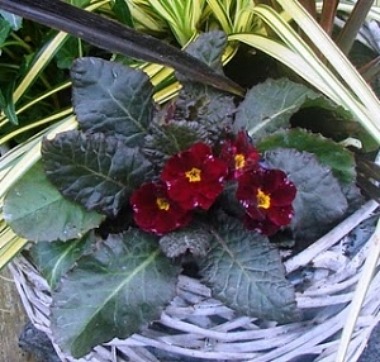Shakespeare’s Ophelia warned her brother about treading down the “primrose path,” a phrase the Bard used more than once in his plays to refer to the pleasant path to self-destruction. But to the Irish, a primrose path meant something quite different. It became traditional to plant primroses around the entrance to one’s cottage to protect against evil fairies.
“And it must work,” says Kilkenny nurseryman Pat FitzGerald. “Have you met any?”
You’re certainly not going to encounter any evil fairies at FitzGerald’s nursery in Oldtown, Stoneyford, in southeastern Ireland, built on the farm where FitzGerald grew up. And you will find primroses. As a child, FitzGerald recalls picking wild primroses by the fistful in the Rath, or Neolithic ring fort, on the property. He and his siblings used to “play hideaway” in the fort, which was covered in primroses, violets, and bluebells and which he rescued from its bramble prison when he founded the nursery in 1990.
“But I’d never grown a primrose till three or four years ago,” FitzGerald told me a few weeks ago on the phone from Ireland. “They were so familiar I guess I treated them with a little bit of contempt.”
Then he met an amateur primrose breeder and retired dentist named Joe Kennedy, a Carlow man living in County Antrim, who has been collecting old Irish varieties of primula—the flower’s Latin name—some dating back to the late 19th century. Out of hardy Irish stock of a perennial primrose known as Garryard, Kennedy had bred some unusual plants with very dark foliage that makes them look almost sensual. They’re a reminder that the primrose’s only magic—its only use—is to look pretty. And they do.
FitzGerald is bringing some of these dark wonders with him to debut at the Philadelphia International Flower Show, which opens this Sunday, March 6, at the Philadelphia Convention Center. Though the theme this year is “Springtime in Paris,” Tourism Ireland is a show sponsor so, among the outdoor Paris cafes and the replicas of Versailles, there will be a tribute to the iconic Irish oak, now an endangered species. FitzGerald will introduce and talk about the Kennedy Irish Primroses on Tuesday, March 8, at 4 PM in the Subaru Gardener’s Studio. (And yes, he’s brought some to sell.)
Appropriately, each of the new primroses carries a name linked to Irish poet William Butler Yeats. The first, Inisfree, comes from Yeats’ poem “The Lake Isle of Inisfree,” and is a mat-forming variety with deep red and yellow blooms with very dark purple foliage. The second, Drumcliffe, named for the village graveyard where the poet is buried, is a rosette forming variety with a creamy white flower that opens with a slight touch of mauve.
And the timing is appropriate too, says FitzGerald. This year marks the 50th anniversary of the inauguration of President John Fitzgerald Kennedy, whose family comes from County Wexford. “But this collaboration between a Fitzgerald and a Kennedy to bring old Irish primroses to America is a typically Irish coincidence,” jokes FitzGerald.
Kennedy and FitzGerald are working on 36 more primrose selections, the next of which may be unveiled next year in a variety of colors, including yellow, white, peach, and pink with intensely dark purple foliage.
When he started his company more than 20 years ago, FitzGerald had no idea that his was going to be anything more than a local business. In fact, he didn’t even start out to be a nurseryman per se. After college, he set up his first nursery as a workshop for people with special needs, affiliated with the Brothers of Charity. “Our work was to train people with disabilities, brain injuries, and various forms of mental disability to work in the commercial nursery.”
Then, January 2009, he discovered the social network. Facebook. Twitter. Blogging. He got himself Facebook and Twitter accounts and writes a blog called “My Plant” at Blogspot. Suddenly, his plants were showing up in the US, particularly a shrub called ceanothus, a small tree or shrub in the buckthorn family. His variety is called Tuxedo because it has black leaves—actually, a dark chocolate color with striking red stems and lavender blue flowers. And his carex—a kind of grass—called Everillo is making the rounds on other plant sites and blogs.
“The amount of people I’ve made connections with because of it is amazing,” says FitzGerald. “The first place to find out about plants these days is Facebook. People who are in the business are now scouting it. I’ve been using it pretty actively for 18 months now and spreading the word about our plants, and I don’t think it would have happened any other way. We don’t have the budget to take ads in major magazines. In my experience, getting plants into nurseries has never happened this fast. Going to a trade show would cost me something like 1500 euros and I sometimes would come back scratching my head and wondering, ‘Did anything really come of that?’ Social network sites are like a permanent trade show—your door is permanently open and the good and the bad come in.”
Others have noticed. FitzGerald’s company was short-listed for the Irish Times 2011 Innovation Awards in recognition not only of its unique plant cultivars but for the “unique and cost effective route” it took to access world markets.
But posting on Facebook isn’t his main focus, says FitzGerald, “You still have to do the day job. It doesn’t watch the dishes.” And that means getting his primroses ready for the American market. They’re being produced at his lab which is about 20 miles from the old Kennedy homestead in Wexford. Just another one of those typical “Irish coincidences,” he laughs.


